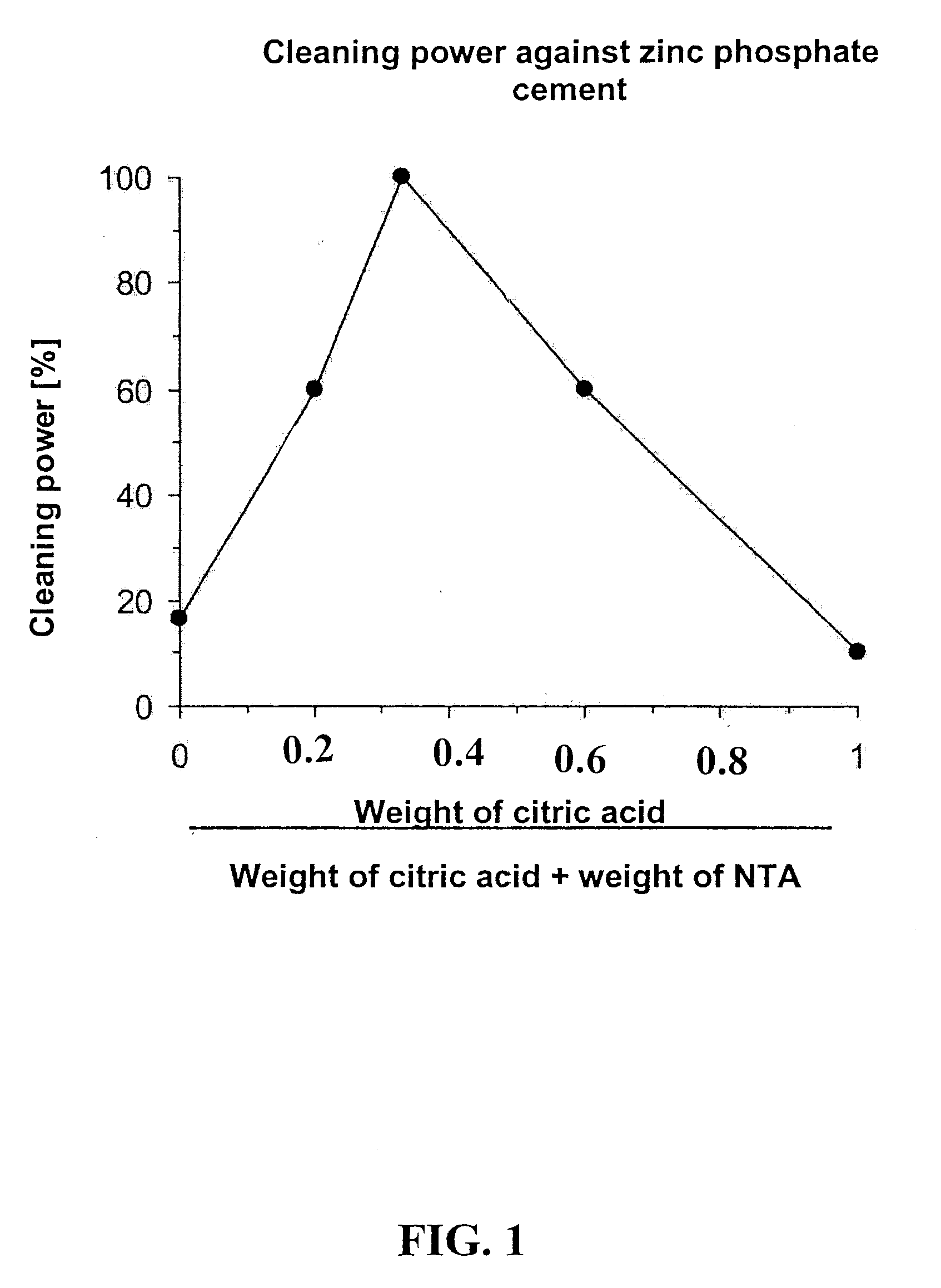Composition for Cleaning Dental Instruments and Process
a technology for dental instruments and composites, applied in the direction of detergent compositions, detergent compounding agents, non-surface active detergent compositions, etc., can solve the problems of uneconomical cost-benefit ratio, difficult cleaning operation of impression trays, and even more difficult removal of materials
- Summary
- Abstract
- Description
- Claims
- Application Information
AI Technical Summary
Benefits of technology
Problems solved by technology
Method used
Image
Examples
examples 1 to 16
Compositions for Cleaning Dental Instruments
[0140]
Example:1234*5*6*7*8*9*10*11*1213Nitrilotriacetate121114282848.5284148.548.5506070(pt. by wt.)Citric acid28.525.53330302530192525151010(pt. by wt.)Sodium17304.92012202015carbonate(pt. by wt.)Sodium3933.543.6393939252013bicarbonate(pt. by wt.)C16C18-fatty04.50.50.50.52alcoholethoxylates(pt. by wt.)Na fatty alcohol2.5001.532sulfate(pt. by wt.)Polyethylene01.5351.52.6303glycol 6000(pt. by wt.)Starch1.5(pt. by wt.)5-Methyl-1131.5benzotriazole-sodium(pt. by wt.)Benzotriazole-1.5Na (pt. by wt.)NaH2PO4,000.48157Na2HPO4(pt. by wt.)pH after mixing997.59.59.58.59.598.58.59109.5with 4,000 pt. bywt. of waterpH after mixing9.29.17.49.49.58.59.59.18.48.69.110.19.4with 2,000 pt. bywt. of waterpH after mixing8.58.57.39.29.28.29.18.78.18.18.79.69.0with 10,000 pt.by wt. of waterExample:14*15*16*Nitrilotriacetic acid302439(pt. by wt.)Trisodium citrate20.11621.2(pt. by wt.)Sodium carbonate43.43434.5(pt. by wt.)Na diimidosuccinate019.5(pt. by wt.)C16C18...
example 17
Tablet
[0145] A composition according to Example 6 was prepared as a tablet. For this, the thoroughly mixed constituents were introduced into a steel cylinder (diameter 40 mm, height 60 mm) and pressed by means of a die. By means of a hydraulic system, a weight of 3 t acted on the die. [0146] A composition according to Example 16 was prepared as a tablet in an analogous manner.
example 18
Method for Quantitative Determination of a Cleaning Action (cf. also Examples 19, 20 and 21)
[0147] For each cleaning solution to be investigated, identical disc-shaped test specimens (diameter 2 cm + / −0.2 mm, thickness 2 mm + / −0.1 mm) of a certain cement (see below and Examples 19, 20 and 21) were produced and weighed. Aqueous cleaning solutions (see Examples 19, 20 and 21) were prepared by dissolving in each case 100 parts by weight of certain compositions in 4,000 parts by weight of water. The identical test specimens were in each case suspended by means of a net (mesh width 500 μm) in 250 ml of the particular aqueous cleaning solution (20° C.). [0148] After the test specimens had been immersed in the particular solution for 3 h (e.g. alginate, zinc polycarboxylate) or 8 h (e.g. zinc phosphate), the solution was sucked off through a tared glass frit and the residue was washed three times with 20 ml of water each time, dried to constant weight at 150° C. and weighed. The weight of...
PUM
 Login to View More
Login to View More Abstract
Description
Claims
Application Information
 Login to View More
Login to View More - R&D
- Intellectual Property
- Life Sciences
- Materials
- Tech Scout
- Unparalleled Data Quality
- Higher Quality Content
- 60% Fewer Hallucinations
Browse by: Latest US Patents, China's latest patents, Technical Efficacy Thesaurus, Application Domain, Technology Topic, Popular Technical Reports.
© 2025 PatSnap. All rights reserved.Legal|Privacy policy|Modern Slavery Act Transparency Statement|Sitemap|About US| Contact US: help@patsnap.com


